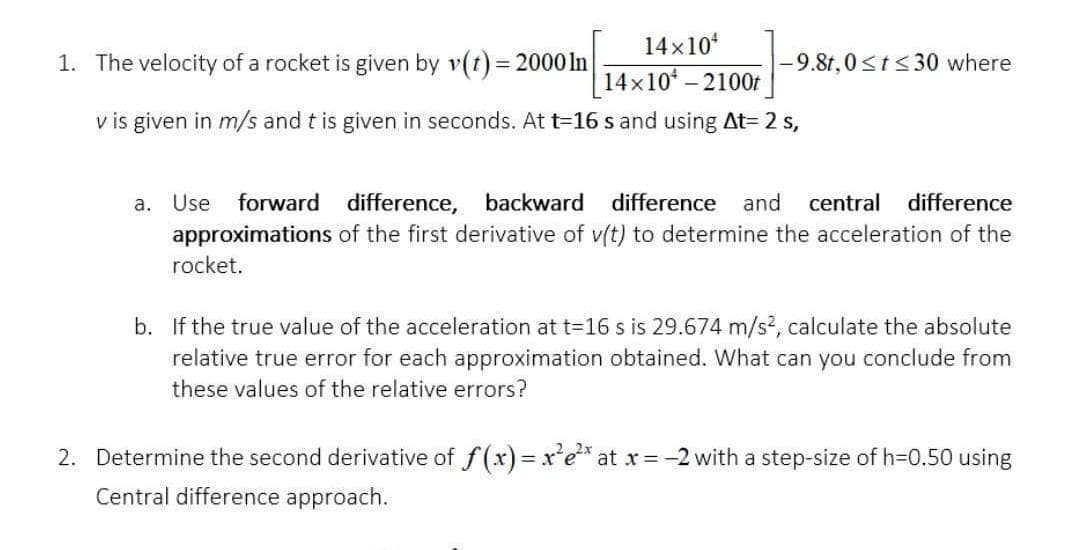14x10 1. The velocity of a rocket is given by v(t) = 2000 In -9.8t,0≤t≤30 where 14×10¹ - 2100t v is given in m/s and t is given in seconds. At t=16 s and using At=2 s, a. Use forward difference, backward difference and central difference approximations of the first derivative of v(t) to determine the acceleration of the rocket. b. If the true value of the acceleration at t=16 s is 29.674 m/s², calculate the absolute relative true error for each approximation obtained. What can you conclude from these values of the relative errors?
14x10 1. The velocity of a rocket is given by v(t) = 2000 In -9.8t,0≤t≤30 where 14×10¹ - 2100t v is given in m/s and t is given in seconds. At t=16 s and using At=2 s, a. Use forward difference, backward difference and central difference approximations of the first derivative of v(t) to determine the acceleration of the rocket. b. If the true value of the acceleration at t=16 s is 29.674 m/s², calculate the absolute relative true error for each approximation obtained. What can you conclude from these values of the relative errors?
Functions and Change: A Modeling Approach to College Algebra (MindTap Course List)
6th Edition
ISBN:9781337111348
Author:Bruce Crauder, Benny Evans, Alan Noell
Publisher:Bruce Crauder, Benny Evans, Alan Noell
Chapter2: Graphical And Tabular Analysis
Section2.1: Tables And Trends
Problem 1TU: If a coffee filter is dropped, its velocity after t seconds is given by v(t)=4(10.0003t) feet per...
Related questions
Question
Advance Math

Transcribed Image Text:14x10¹
1. The velocity of a rocket is given by v(t) = 2000 In
-9.8t, 0≤t≤30 where
14×10¹ - 2100t
v is given in m/s and t is given in seconds. At t=16 s and using At= 2 s,
a. Use forward difference, backward difference and central difference
approximations of the first derivative of v(t) to determine the acceleration of the
rocket.
b. If the true value of the acceleration at t=16 s is 29.674 m/s², calculate the absolute
relative true error for each approximation obtained. What can you conclude from
these values of the relative errors?
2. Determine the second derivative of f(x)=x²e²* at x = -2 with a step-size of h=0.50 using
Central difference approach.
Expert Solution
This question has been solved!
Explore an expertly crafted, step-by-step solution for a thorough understanding of key concepts.
Step by step
Solved in 5 steps with 5 images

Recommended textbooks for you

Functions and Change: A Modeling Approach to Coll…
Algebra
ISBN:
9781337111348
Author:
Bruce Crauder, Benny Evans, Alan Noell
Publisher:
Cengage Learning

Trigonometry (MindTap Course List)
Trigonometry
ISBN:
9781337278461
Author:
Ron Larson
Publisher:
Cengage Learning


Functions and Change: A Modeling Approach to Coll…
Algebra
ISBN:
9781337111348
Author:
Bruce Crauder, Benny Evans, Alan Noell
Publisher:
Cengage Learning

Trigonometry (MindTap Course List)
Trigonometry
ISBN:
9781337278461
Author:
Ron Larson
Publisher:
Cengage Learning
